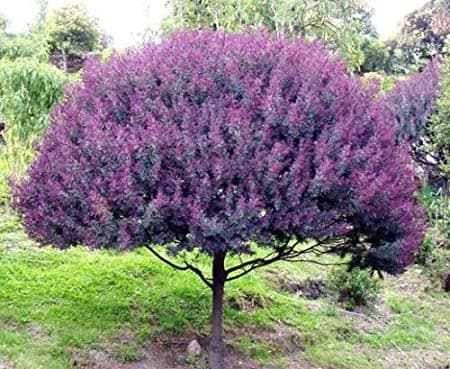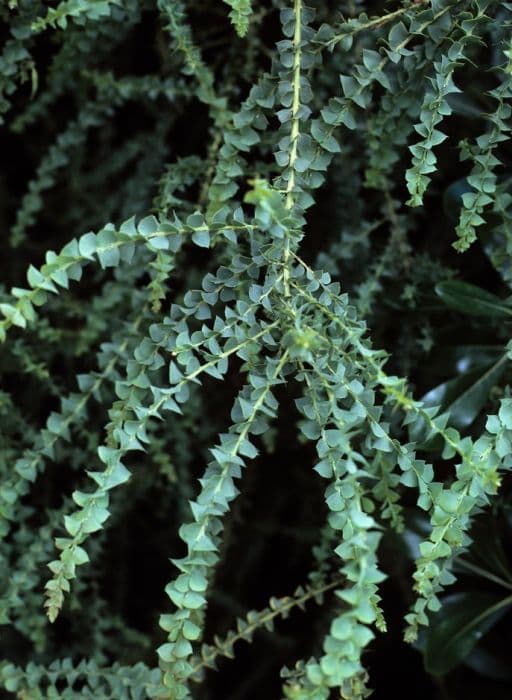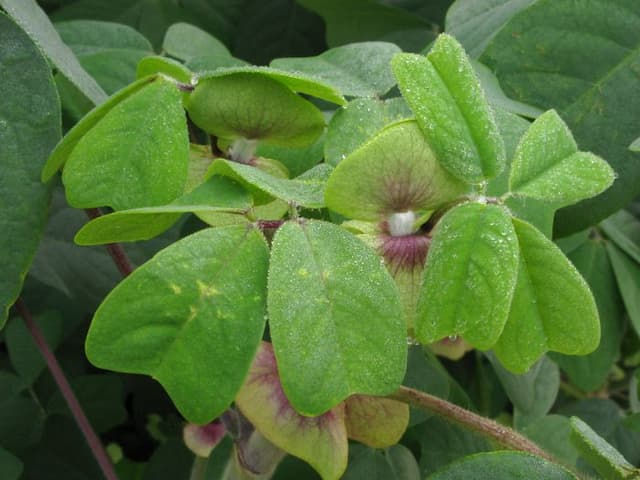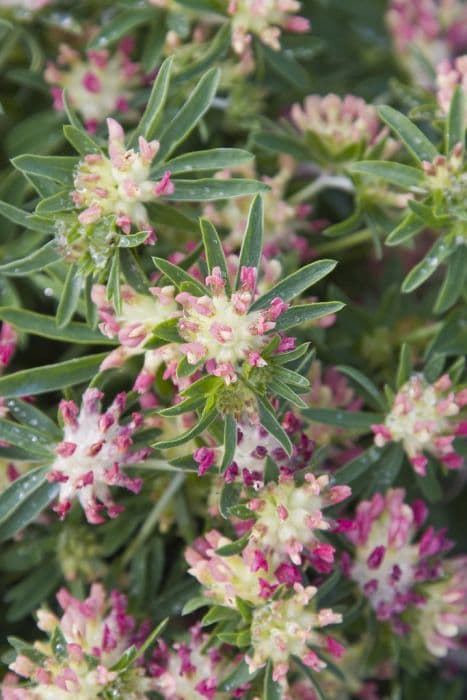Boskoop Ruby Broom Cytisus × boskoopii 'Boskoop Ruby'

ABOUT
Boskoop Ruby is a stunning deciduous shrub known for its ornamental qualities. The plant has a vibrant display of ruby-red flowers that are pea-like in shape, which cover the branches and create a dazzling floral display that is particularly eye-catching. These vivid blooms emerge in late spring to early summer, offering a burst of rich color against the backdrop of its foliage. The leaves of Boskoop Ruby are small, trifoliate – meaning they are composed of three smaller leaflets – and are tapered at the end, possessing a lush green hue that complements the brightness of the flowers. As a garden plant, Boskoop Ruby adds a splash of color and can be pruned to maintain a neat, bushy habit, encouraging a prolific flowering season. Not only does it attract the attention of onlookers, but it's also appealing to pollinators such as bees, which are drawn to the nectar-rich flowers. This plant is compatible with a range of garden settings, from mixed borders to standalone placements, and can be planted alongside other shrubs that enjoy similar growing conditions. Overall, its striking flowers and elegant foliage make it a prized specimen for any ornamental garden.
About this plant
 Names
NamesSynonyms
Boskoop Ruby Broom, Ruby Broom
Common names
Cytisus × boskoopii 'Boskoop Ruby'
 Toxicity
ToxicityTo humans
Scotch Broom, which includes cultivars like Cytisus × boskoopii 'Boskoop Ruby', contains toxic alkaloids such as sparteine and is considered poisonous. Ingesting parts of the plant, particularly the seeds, can lead to symptoms including nausea, vomiting, and diarrhea. In severe cases, it can also cause confusion, dizziness, and potentially life-threatening changes in blood pressure and heart rate. The severity of the symptoms depends on the amount ingested.
To pets
Scotch Broom, which includes cultivars like Cytisus × boskoopii 'Boskoop Ruby', is toxic to pets due to its content of harmful alkaloids, such as sparteine. If pets ingest parts of this plant, specifically the seeds, they may exhibit symptoms like vomiting, diarrhea, and abdominal pain. More serious consequences include heart arrhythmias and changes in blood pressure. The toxicity level can vary based on the size of the pet and the amount of plant material ingested.
 Characteristics
CharacteristicsLife cycle
Perennials
Foliage type
Deciduous
Color of leaves
Green
Flower color
Red
Height
5 feet (1.5 meters)
Spread
5 feet (1.5 meters)
Plant type
Shrub
Hardiness zones
6
Native area
Europe
Benefits
 General Benefits
General Benefits- Attractive Flowers: Cytisus × boskoopii 'Boskoop Ruby', commonly known as Scotch Broom, produces vibrant ruby-red flowers that add a splash of color to landscapes and gardens.
- Drought Tolerance: Once established, Scotch Broom is highly drought-tolerant, requiring minimal watering and making it suitable for xeriscaping or areas with water restrictions.
- Low Maintenance: This plant requires limited maintenance, as it does not need regular pruning or deadheading, making it convenient for gardeners with limited time.
- Fast Growth: Scotch Broom grows relatively quickly, which makes it useful for gardeners wanting to establish a visual impact in a short period of time.
- Erosion Control: Its robust root system can help stabilize soil, making it an excellent choice for controlling erosion on banks and slopes.
- Wildlife Attraction: The flowers attract pollinators such as bees, which are vital for the health of many ecosystems and the pollination of surrounding plants.
- Adaptable: It can thrive in a range of soil types, from sandy to loamy, as long as the soil is well-drained.
- Deer Resistant: Scotch Broom is typically resistant to browsing by deer, which can be beneficial in areas where deer predation is a concern for gardeners.
 Medical Properties
Medical PropertiesThis plant is not used for medical purposes.
 Air-purifying Qualities
Air-purifying QualitiesThis plant is not specifically known for air purifying qualities.
 Other Uses
Other Uses- Scotch broom cultivars like 'Boskoop Ruby' can be used in floral arrangements for their colorful and vibrant flowers which provide a striking visual interest.
- The plant can act as a natural fence or screen when planted in a dense row due to its bushy growth habit, offering privacy to gardens.
- With its dense foliage, Scotch broom serves as a refuge and nesting site for various species of birds, promoting biodiversity.
- You can utilize Scotch broom in erosion control due to its root system which helps stabilize soil on slopes and banks.
- The branches of Scotch broom can be used in basket weaving to create garden structures like plant supports or decorative items.
- 'Boskoop Ruby', due to its vibrant flowers, can be planted to enhance apicultural value as it attracts bees and other pollinators.
- The plant's durability against coastal conditions makes it suitable for planting in seaside gardens where other plants might not thrive.
- Scotch broom's rapid growth and tolerance of poor soils can be employed in reclaiming and beautifying disturbed lands, such as landfills or mining sites.
- When used in controlled settings, 'Boskoop Ruby' can serve as a teaching tool for invasive species management and habitat restoration topics.
- In landscape design, the plant's vivid flowers and arching branches can be used to add an element of structural contrast in mixed borders or rock gardens.
Interesting Facts
 Feng Shui
Feng ShuiThe Scotch Broom is not used in Feng Shui practice.
 Zodiac Sign Compitability
Zodiac Sign CompitabilityThe Scotch Broom is not used in astrology practice.
 Plant Symbolism
Plant Symbolism- Renewal: As a flowering shrub that blooms with vibrant color each year, the Scotch Broom (Cytisus × boskoopii 'Boskoop Ruby') often symbolizes new beginnings and the idea of renewal, embracing change and transformation with its cycles of growth.
- Adaptability: Being a hardy plant that can thrive in challenging conditions, Scotch Broom represents the ability to adapt to various environments and circumstances, encouraging resilience in life.
- Purification: Historically, broom plants, including Scotch Broom, were used for sweeping, and metaphysically, they are thought to symbolize cleansing and purification, driving out negative energy and ushering in positive influences.
- Protection: Scotch Broom is sometimes linked with protection due to its sturdy nature and the way it can dominate a landscape, providing shelter to wildlife, symbolizing a safeguard against adversity.
 Water
WaterThe Scotch Broom (Cytisus × boskoopii 'Boskoop Ruby') prefers to be watered when the top inch of soil feels dry to the touch; overwatering can lead to root problems, so it's important to ensure good drainage. Typically, watering once a week with approximately 1-2 gallons per plant should suffice, but this can vary with climate, season, and soil conditions. During hot, dry spells, more frequent watering may be necessary. In winter, reduce watering as the plant goes dormant. Always water the soil directly rather than overhead to avoid wetting the foliage, which can lead to fungal diseases.
 Light
LightThe Scotch Broom (Cytisus × boskoopii 'Boskoop Ruby') thrives best in full sunlight, receiving at least 6 to 8 hours of direct sun each day. The ideal location would ensure unobstructed exposure to sunlight to encourage the best flowering and growth. If grown indoors or in regions with less intense sunlight, placing it in the brightest spot available is crucial for its health and flower production.
 Temperature
TemperatureThe Scotch Broom (Cytisus × boskoopii 'Boskoop Ruby') prefers a moderate temperature range; it handles cold quite well, surviving temperatures down to about 10°F. The ideal growing conditions are between 60°F and 75°F. This plant tends to be hardy in USDA zones 5 through 8, which corresponds to a wide range of climates, but it should be protected from extreme heat or cold outside of these temperature bounds.
 Pruning
PruningPrune the Scotch Broom (Cytisus × boskoopii 'Boskoop Ruby') to maintain its shape and remove any dead or weak stems, which encourages healthy growth and prolific flowering. Pruning should be done immediately after flowering, typically in late spring or early summer. Cutting back about one-third of the growth each year can prevent the plant from becoming leggy and promotes denser, more attractive foliage.
 Cleaning
CleaningAs needed
 Soil
SoilScotch Broom 'Boskoop Ruby' thrives in well-draining, sandy or loamy soil enriched with organic matter. The ideal soil pH for this plant is slightly acidic to neutral, ranging from 6.0 to 7.5. Amend the native soil with compost or peat to improve texture and fertility.
 Repotting
RepottingScotch Broom 'Boskoop Ruby' is typically grown outdoors and does not require frequent repotting. Should it be grown in containers, repotting every 2-3 years might suffice to refresh the soil and provide ample growing space for the roots.
 Humidity & Misting
Humidity & MistingScotch Broom 'Boskoop Ruby' is adaptable and does not require high humidity levels, making it suitable for average outdoor conditions. Ensuring good air circulation around the plant will help maintain appropriate humidity levels for robust growth.
 Suitable locations
Suitable locationsIndoor
Grow in bright light, well-draining soil, and moderate temps.
Outdoor
Full sun, well-draining soil, protect from harsh winter.
Hardiness zone
6-8 USDA
 Life cycle
Life cycleScotch Broom 'Boskoop Ruby', a hybrid plant, begins its life cycle with seed germination, usually in the spring, when temperatures become suitable for growth. The seedlings rapidly develop into young plants with a distinctive green, slender foliage. Through the spring and early summer, the plant enters a vigorous growth phase, characterized by the production of numerous ruby-red flowers that attract pollinators. After pollination, the flowers give way to legume pods, which mature by late summer and eventually split open to disperse seeds. The plant enters a dormant phase in the fall and winter, conserving energy and resources. With the return of favorable conditions in the following spring, Scotch Broom 'Boskoop Ruby' awakens from dormancy and the cycle begins anew, with the plant ready to grow and reproduce once again.
 Propogation
PropogationPropogation time
Late winter to early spring
The Scotch Broom 'Boskoop Ruby' is commonly propagated by semi-hardwood cuttings taken in late summer. To do so, choose a healthy, non-flowering stem and cut a segment around 4 to 6 inches (10 to 15 cm) long. Remove the leaves from the lower half of the cutting, dip the cut end into rooting hormone, and plant it in a pot filled with a mix of peat and perlite or sand. The cutting should be kept moist and placed in a warm, bright location out of direct sunlight until roots develop, which usually takes several weeks. Once rooted, the new Scotch Broom plants can be potted up into individual containers or planted out in the garden.









